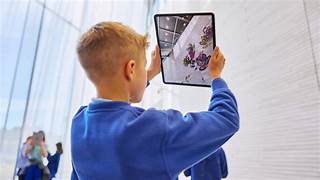The classroom of the future isn’t just about smartboards and tablets — it’s about immersive, interactive, and personalized learning experiences . And at the heart of this transformation is Augmented Reality (AR) .
AR technology is no longer science fiction. It’s being used today to bring lessons to life, help students visualize complex concepts, and make learning more engaging than ever before.
In this article, we’ll explore how future classrooms are being powered by AR , why it matters for educators, and what tools are shaping tomorrow’s learning environments.

What Is Augmented Reality?
Before diving into its impact on education, let’s define Augmented Reality (AR) simply.
AR enhances the real world by overlaying digital content — such as images, videos, or 3D models — onto a user’s environment using devices like smartphones, tablets, or AR glasses. Unlike Virtual Reality (VR), which creates an entirely artificial environment, AR blends digital elements with the physical world, making it ideal for classroom use.
This makes AR especially valuable in education — where abstract concepts can be made tangible, and passive learning can become active exploration.
Why Traditional Classrooms Need Innovation
Traditional teaching methods — lectures, textbooks, and standardized tests — have remained largely unchanged for decades. While effective in many ways, they often fail to engage modern learners who are used to visual, interactive, and personalized digital experiences.
Here’s why innovation is essential:
- 📉 Student engagement is declining.
- 🧠 Passive learning leads to poor retention.
- 💡 Students today expect interactivity and instant feedback.
- 🌐 Remote and hybrid learning demands new tools.
This gap between student expectations and classroom delivery has created a demand for technologies that can bridge the divide — and AR is emerging as a strong contender.
How AR Transforms Future Classrooms
AR is not just a tool — it’s a classroom revolution . Here’s how it’s shaping the future of education:
1. Immersive Learning Experiences
AR transforms static content into dynamic, interactive experiences. This helps students understand complex topics faster and retain knowledge longer.
For example:
- Explore the human body layer by layer
- Walk through ancient civilizations using your classroom floor
- Manipulate 3D molecules to see chemical reactions unfold
These kinds of experiences make learning feel less like a lesson and more like an adventure.
2. Personalized Learning Paths
With AI integration, AR can adapt to individual learning styles and paces — offering customized explanations and challenges tailored to each student.
This personalization ensures that every learner gets the support they need — whether they’re struggling with basic math or exploring advanced physics.
3. Supports Remote and Hybrid Learning
Especially post-pandemic, educators need tools that bring remote students into the same learning environment. AR enables virtual field trips, lab simulations, and collaborative projects from anywhere.
Students can now conduct experiments, explore historical events, and even dissect virtual frogs — all without needing to be physically present in class.
4. Increases Engagement and Motivation
Gamification elements in AR apps — like points, badges, and leaderboards — encourage students to stay focused and motivated.
Many teachers report higher participation levels when using AR-powered lessons, especially among students who typically struggle with traditional instruction.
5. Cost-Effective Simulations
AR can replicate expensive equipment or rare experiences — like space travel or deep-sea exploration — at a fraction of the cost.
This means schools can offer high-quality STEM labs, language immersion programs, and cultural studies without breaking the budget.
Benefits of AR in Future Classrooms
Let’s break down some of the most impactful benefits AR brings to education:
| Benefit | Description |
|---|---|
| 🧠 Enhanced Visualization | Abstract ideas become tangible through 3D models and interactive visuals. |
| 🎯 Better Student Motivation | Gamified AR lessons increase attention span and participation. |
| 🧑🏫 Inclusive Learning | Supports diverse learning needs, including special education and language learners. |
| 💻 Cost-Effective Tools | Reduces reliance on physical materials and lab setups. |
| 📱 Scalability | Works across subjects, age groups, and learning environments. |
These benefits suggest that AR has the potential not only to enhance current education systems but also to revolutionize them.
Top AR Tools That Will Shape Future Classrooms
Here are some of the best AR platforms currently transforming how students learn:
| Tool | Best For | Key Features |
|---|---|---|
| Merge Cube | STEM Education | 3D object manipulation, tactile learning |
| zSpace | Advanced STEM | Hybrid AR/VR platform for in-depth exploration |
| Adobe Aero | Custom Content Creation | Create personalized AR lessons without coding |
| HP Reveal (formerly Aurasma) | Textbook Enhancement | Turn static pages into interactive AR experiences |
| CoSpaces Edu | Coding & Creativity | Build AR worlds and stories; supports Blockly and JavaScript |
| SkyView® Explore the Universe | Astronomy | Identify stars, planets, and satellites in real time |
| Anatomy 4D | Biology | Explore human body systems in detail |
| Elements 4D | Chemistry | Simulate chemical reactions safely |
| Google Expeditions (Legacy) | Virtual Field Trips | Explore global landmarks and natural wonders |
| Quiver | Elementary Learning | Coloring pages come to life with AR |
Most of these tools are easy to use, compatible with common devices, and many offer free versions — making them accessible for most schools.
Real-World Examples of AR in Action
Let’s look at a few real-life examples of how AR is being used effectively in classrooms:
🔬 Science Class: Virtual Dissections
Instead of using actual frogs, biology students can perform dissections in AR. This eliminates ethical concerns, reduces costs, and allows multiple attempts — increasing both engagement and understanding.
🗺️ History Class: Time Travel Through AR
Students can “stand” beside historical figures, walk through ancient civilizations, or witness key events unfold before their eyes — all from the safety of the classroom.
📐 Math Class: Geometry in 3D
Geometry becomes more engaging when students can manipulate 3D shapes and visualize formulas in action. AR apps allow them to rotate, zoom, and interact with geometric figures like never before.
These examples show that AR isn’t just a futuristic idea — it’s being applied right now to make learning more engaging, inclusive, and effective.
How Teachers Can Prepare for the AR Classroom
You don’t need to be tech-savvy to begin integrating AR into your teaching. Here’s how to get started:
Step 1: Define Your Learning Goals
Identify what you want students to learn. Choose AR tools that align with those objectives.
Step 2: Start Small
Begin with one or two apps that match your subject area and class needs. Many offer free trials or limited versions.
Step 3: Train Yourself
Use tutorials and demo videos to become familiar with the app before introducing it to students.
Step 4: Integrate Into Lessons
Find ways to incorporate AR naturally into your existing curriculum. For example:
- In English, animate story settings.
- In geography, explore topographical maps.
- In social studies, simulate ancient trade routes.
Step 5: Gather Feedback
Ask students how they felt about using AR. This will help you refine future lessons and choose better tools.
Challenges & Solutions
While AR offers many benefits, there are still some hurdles to overcome:
💸 High Costs of Hardware
Some advanced AR tools require special headsets or devices.
Solution: Start with free apps that work on existing devices like smartphones and tablets.
🛠️ Technical Limitations
Not all schools have the infrastructure or bandwidth to support high-quality AR applications.
Solution: Advocate for grants or funding for EdTech initiatives.
📚 Teacher Training
Educators may feel overwhelmed by new technology.
Solution: Provide professional development workshops and peer mentoring.
The Future of AR in Education
As AR technology continues to evolve, we can expect even more innovative applications in education:
👓 Wearable AR Devices
Lightweight AR glasses will replace tablets and smartphones in classrooms, allowing hands-free interaction with digital content.
☁️ Cloud-Based AR Learning
Cloud computing will enable seamless, real-time access to AR content without requiring powerful local devices.
🤖 AI Integration
AI-powered tutors embedded in AR environments will offer real-time guidance, adapting lessons to each student’s progress.
🌐 Global Collaborative Learning
Students from different countries will join the same AR environment to collaborate on projects, breaking down geographical barriers.
Final Thoughts: Embrace AR in Your Classroom
The rise of augmented reality in education is not just a trend — it’s a transformation in how we teach and learn. From elementary classrooms to university lecture halls, AR is helping students visualize complex topics, stay engaged, and take ownership of their learning journey.
If you’re an educator ready to embrace innovation, there’s never been a better time to explore AR. With the right tools and strategies, you can turn your classroom into a dynamic, interactive learning hub where every lesson comes to life.
So why wait? Start experimenting with AR today and unlock a world of possibilities for your students.
Frequently Asked Questions (FAQ)
Q1: How does AR shape future classrooms?
A1: AR boosts engagement, improves retention, encourages self-directed learning, and makes abstract concepts tangible through interactivity.
Q2: Can AR be used in online learning?
A2: Yes, AR is increasingly used in remote and hybrid learning environments to provide hands-on experiences without physical constraints.
Q3: Are AR tools expensive for schools?
A3: While some advanced systems can be costly, many AR apps are free or low-cost and work on existing devices like smartphones and tablets.
Q4: What subjects benefit most from AR?
A4: Science, math, history, and language learning benefit greatly from AR, but it can be applied across nearly all subjects.
Q5: How can teachers start using AR in the classroom?
A5: Begin by identifying learning goals, choosing the right app, testing it yourself, and gradually integrating it into your lessons.
You can also visit here for more info- https://dstrendmedia.com/2025/05/18/ar-tools-every-teacher-should-know/

